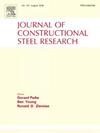Experimental investigation on cold-formed steel built-up columns based on modular component method
IF 4
2区 工程技术
Q1 CONSTRUCTION & BUILDING TECHNOLOGY
引用次数: 0
Abstract
This study aims to investigate the buckling behavior, assembly effects, and ultimate capacity of cold-formed steel columns. The research encompasses five distinct types of cross-sectional columns, namely C-sections, U-sections, modular components, and closed sections, which were analyzed through both experimental and theoretical approaches. The failure modes of the columns were summarized, and the underlying reasons for these failures were elucidated. Compression tests were performed to assess the impact of cross-sectional dimensions, plate assembly effects, and screw spacing. Additionally, evaluations of material properties and measurements of imperfections were conducted. The test results, including the ultimate load, were compared with predictions derived from the current Effective Width Method (EWM) and Direct Strength Method (DSM) design approaches. The results indicate that the EWM tends to be excessively conservative, whereas the DSM presents a marginally unsafe assessment. A novel design method is proposed based on the experimental investigations presented in this paper. This new approach integrates the effects of screw restraint and plate group interactions into the design principles for predicting the ultimate capacity of box section columns, specifically utilizing a superposition method of the modular component. Ultimately, the proposed method was evaluated using test data alongside the EWM and DSM. Reliability analysis demonstrated that the proposed method offers more accurate and safer predictions for ultimate capacity compared to the original EWM and DSM as outlined in the AISI-S100 specifications.
求助全文
约1分钟内获得全文
求助全文
来源期刊

Journal of Constructional Steel Research
工程技术-工程:土木
CiteScore
7.90
自引率
19.50%
发文量
550
审稿时长
46 days
期刊介绍:
The Journal of Constructional Steel Research provides an international forum for the presentation and discussion of the latest developments in structural steel research and their applications. It is aimed not only at researchers but also at those likely to be most affected by research results, i.e. designers and fabricators. Original papers of a high standard dealing with all aspects of steel research including theoretical and experimental research on elements, assemblages, connection and material properties are considered for publication.
 求助内容:
求助内容: 应助结果提醒方式:
应助结果提醒方式:


